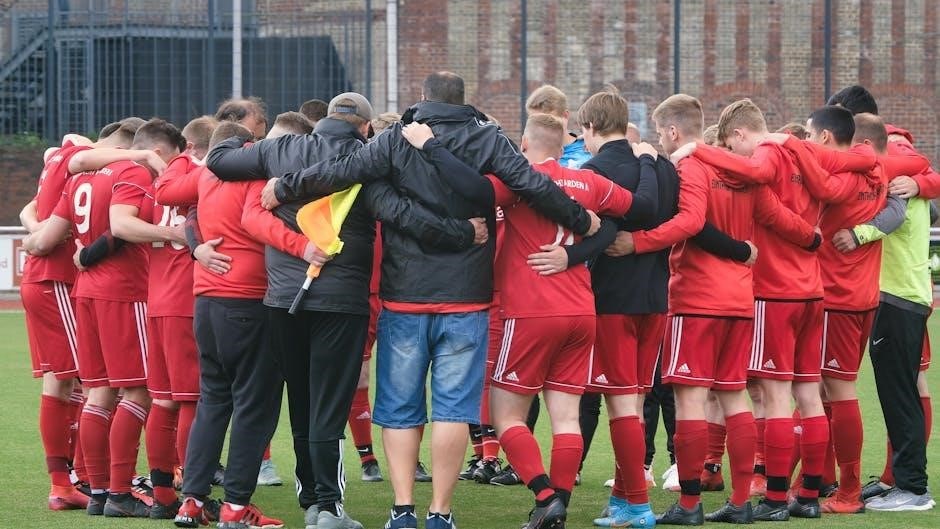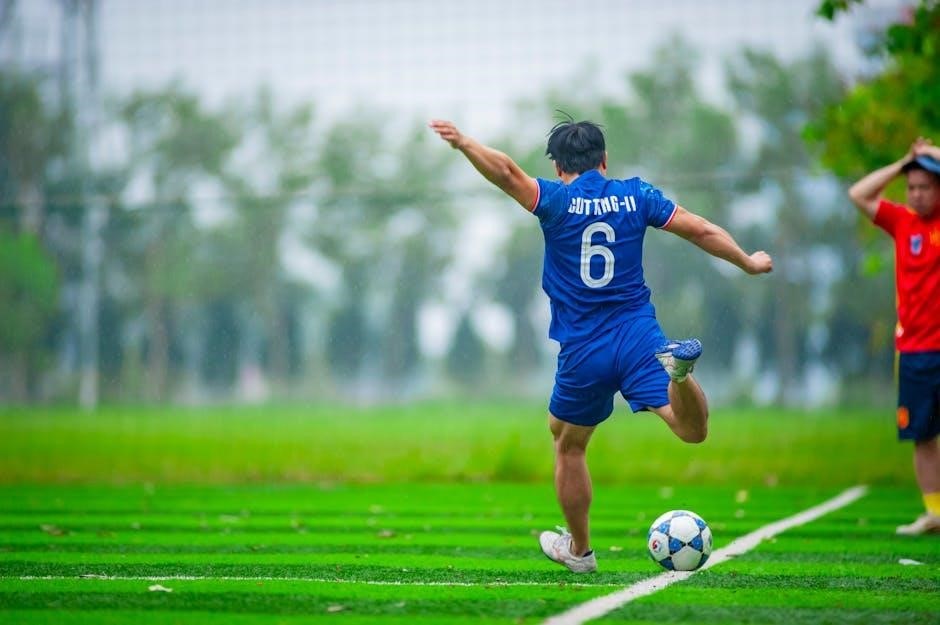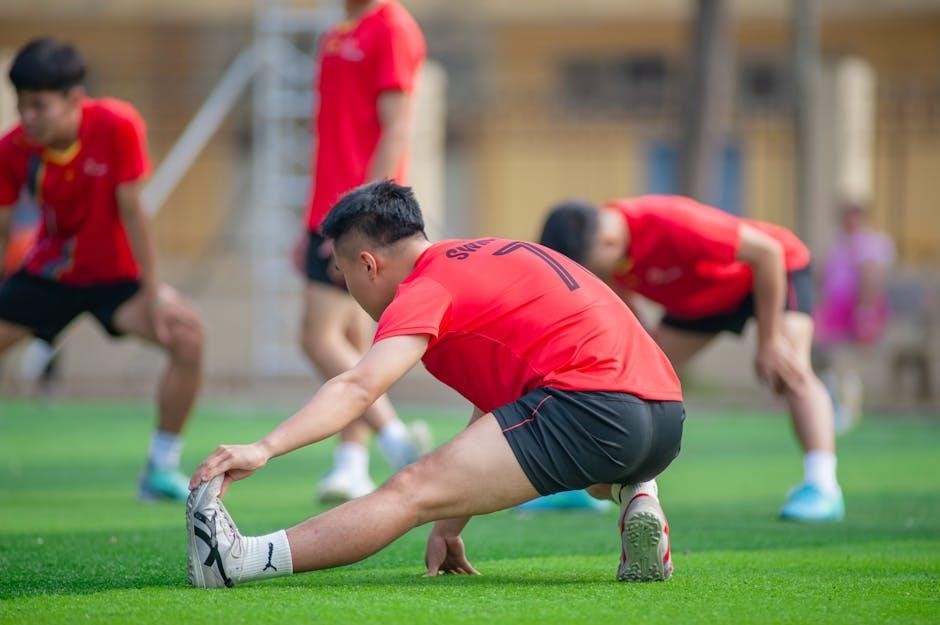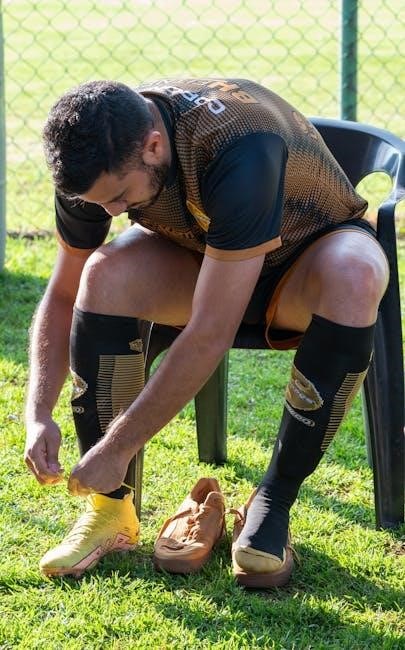A 6-week pre-season soccer training program enhances players’ physical fitness, technical skills, and tactical awareness, preparing them for the upcoming season. Designed for teams and athletes seeking to build strength, improve endurance, and refine strategies, this structured plan ensures peak performance and readiness for competitive play.

Overview of the Program Structure
The 6-week pre-season soccer training program is a comprehensive, structured plan designed to progressively enhance players’ physical fitness, technical skills, and tactical awareness. Each week focuses on specific development areas, ensuring a balanced approach to building strength, endurance, and team cohesion. The program includes a mix of on-field drills, conditioning exercises, and strategic sessions, with a gradual increase in intensity to prepare players for competitive matches. Weekly sessions are divided into fitness, technical, and tactical components, with integrated injury prevention strategies and recovery techniques; This structured progression ensures players are physically and mentally ready for the demands of the season, fostering peak performance and long-term success.
Key Objectives and Benefits
The primary objective of the 6-week pre-season soccer training program is to enhance players’ overall performance by improving fitness, technical skills, and tactical awareness. It aims to build endurance, strength, speed, and agility while fostering team cohesion and strategic understanding. The program also emphasizes injury prevention through structured warm-ups and recovery techniques. By the end of the six weeks, players should demonstrate improved physical conditioning, sharper technical execution, and a clearer understanding of game strategies. This comprehensive approach ensures athletes are mentally and physically prepared to compete at their best, reducing the risk of injuries and enhancing overall team performance throughout the season.
Weekly Breakdown of the Training Program
A six-week structured program progressing from foundational fitness and technical skills to enhanced endurance, strength, speed, agility, team strategy, and final match preparation.

Week 1: Building Foundations ⏤ Fitness and Technical Skills
The first week focuses on establishing a strong foundation in fitness and technical abilities. Players engage in aerobic exercises, such as jogging and high-intensity interval training (HIIT), to improve cardiovascular endurance. Technical drills, including dribbling, passing, and ball control, are emphasized to refine fundamental soccer skills. Coaches introduce basic tactical concepts, such as movement and positioning, to enhance players’ understanding of the game. Strength training is incorporated to build muscle endurance, with a focus on core stability and injury prevention. This week sets the stage for more intense training in subsequent weeks by ensuring players are physically and technically prepared. Proper warm-ups and cool-downs are stressed to prevent injuries and promote recovery.
Week 2: Enhancing Endurance and Tactical Awareness

Week 2 focuses on improving endurance and tactical understanding. Players participate in high-intensity interval training (HIIT) and prolonged aerobic exercises to boost stamina. Tactical drills emphasize positional awareness, decision-making, and teamwork. Small-sided games are introduced to simulate match scenarios, fostering adaptability and problem-solving. Coaches incorporate exercises to enhance reaction speed and spatial awareness, crucial for reading the game. Additionally, video analysis sessions help players review their performance and understand strategic plays. This week bridges the gap between individual skills and collective execution, preparing the team for cohesive gameplay. The emphasis is on building mental and physical resilience to meet the demands of competitive matches.
Week 3: Developing Strength and Power
Week 3 emphasizes building strength and power to enhance explosiveness and durability. Players engage in resistance training, plyometric exercises, and core-strengthening workouts. Sessions include weightlifting to improve muscular endurance and sprinting exercises to boost power output. Tactical drills incorporate strength-based movements to simulate game scenarios. Coaches focus on proper technique to prevent injuries and maximize gains. The integration of strength and power training prepares players for the physical demands of the season, enabling them to compete at a higher intensity. This phase is crucial for developing the robustness needed to excel in competitive matches and maintain performance throughout the season. Consistency and progressive overload are key to achieving desired results.
Week 4: Improving Speed and Agility

Week 4 focuses on enhancing speed and agility through specialized drills and exercises. Players participate in resisted sprint training, plyometric exercises, and ladder drills to improve acceleration and quick directional changes. Cone exercises and zigzag runs are incorporated to boost agility and coordination. Small-sided games with high-intensity intervals simulate match scenarios, allowing players to apply their newfound speed in competitive situations. Strength training continues, with an emphasis on explosive power. Coaches monitor progress, ensuring proper technique to prevent injuries. This phase is vital for developing the speed and agility needed to outpace opponents and excel in fast-paced games. Consistency and progression are key to achieving measurable improvements.
Week 5: Focusing on Team Cohesion and Strategy
Week 5 emphasizes building team cohesion and refining strategic play. Players engage in small-sided games and tactical drills to enhance communication and decision-making. Position-specific training is introduced to clarify roles and responsibilities. Coaches focus on shaping the team’s playing style, emphasizing ball possession, pressing, and defensive organization. Video analysis sessions are used to review game scenarios and improve understanding of systems. Team-building activities foster unity and trust among players. This phase prepares the team to function as a cohesive unit, ensuring they are tactically prepared for competitive matches; The focus is on translating individual skills into collective success, laying the foundation for a strong season.
Week 6: Match Preparation and Tapering
Week 6 focuses on match preparation and tapering, reducing training volume to allow players to recover and peak for the first competitive match. Tactical drills and positional play are refined, with emphasis on mental preparation and team cohesion. Friendly matches simulate game conditions, helping players adapt to real scenarios. Coaches ensure strategies are solidified, and players are mentally and physically ready. This phase ensures the team enters the season prepared and confident, ready to perform at their best.

Injury Prevention and Recovery Strategies
Injury prevention and recovery strategies are crucial for maintaining player health and performance. Proper warm-ups, recovery techniques, and monitoring ensure players stay injury-free and optimize their training outcomes effectively.

Importance of Warm-Up and Cool-Down Routines
A proper warm-up and cool-down are essential for optimizing performance and preventing injuries. Warm-ups increase heart rate, activate muscles, and prepare the body for intense training, reducing the risk of strains and pulls. Cool-downs help lower heart rate gradually, promote blood flow, and aid in muscle recovery. Both routines enhance flexibility and range of motion, crucial for soccer-specific movements. Incorporating dynamic stretches and light cardio during warm-ups improves mobility, while static stretches and foam rolling during cool-downs reduce muscle tension. Consistent use of these routines ensures players maintain peak physical condition and recover effectively, making them indispensable in the 6-week pre-season program.
Role of Nutrition in Recovery
Nutrition plays a vital role in recovery during a 6-week pre-season soccer program. Proper fueling helps replenish energy stores, repair muscles, and support overall physical adaptation. Post-training meals should include a balance of carbohydrates and proteins to restore glycogen levels and promote muscle recovery. Hydration is equally important to replace lost fluids and electrolytes. A diet rich in antioxidants, vitamins, and minerals aids in reducing muscle soreness and inflammation. Players should avoid processed foods and focus on whole, nutrient-dense meals. Timing meals within 30-60 minutes post-session maximizes recovery benefits. A well-planned nutrition strategy ensures players can handle the demands of intense training and perform at their best.
A well-structured 6-week pre-season program maximizes effectiveness. Consistency, dedication, and proper recovery are key. Stay committed, maintain discipline, and trust the process to achieve peak performance.
Maximizing the Program’s Effectiveness
To maximize the effectiveness of a 6-week pre-season soccer program, focus on progressive overload, ensuring each week builds on the previous one. Incorporate a mix of fitness, technical, and tactical drills to address all aspects of player development. Tailor sessions to team needs, and monitor progress through testing and feedback. Emphasize proper nutrition, hydration, and recovery techniques to prevent injuries and enhance performance. Creating a positive team environment fosters motivation and accountability, leading to better overall results. Consistency and adherence to the program are crucial for achieving peak readiness by the end of the six weeks.
Maintaining Consistency and Motivation
Consistency and motivation are vital throughout the 6-week pre-season program. Establishing a daily routine with clear goals helps players stay focused and committed. Coaches should foster a positive team culture, encouraging open communication and accountability. Regular feedback and progress tracking can boost morale, while celebrating small achievements keeps motivation high. Incorporating variety in training sessions prevents monotony and maintains engagement. Ensuring players understand the purpose of each exercise enhances buy-in. Team-building activities strengthen unity, creating a cohesive and driven squad. Maintaining consistency in effort and attitude ensures steady progress, while motivation sustains players through challenges, ultimately preparing them for the demands of the season ahead.
